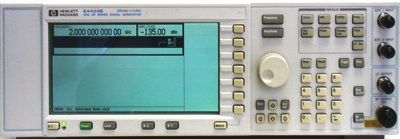
|
|
The Agilent E4423B ESG-AP Analog RF Signal Generator provides all of the features of ESG-A, plus enhanced phase-noise performance. Frequency range: 250 kHz to 1000 MHz, with a 0.01 Hz resolution. Typical switching speed with modulation enabled: <65 ms; with modulation disabled: <55 ms. Sweep Modes: Step: frequency and power, and arbitrary list. Dwell time: 1 ms to 60 sec. Number of points: 2 to 401. Sweep Modes: Step: frequency and power, and arbitrary list. Internal reference oscillator timebase stability: aging rate of <+/- 0.1 ppm per year. Timebase reference output frequency: 10 MHz; output voltage: >0.35 V rms into a 50 Ohm load. External reference input frequencies: 1, 2, 5, 10 MHz +/- 1 ppm; amplitude: >0.15 V rms; input impedance: 50 Ohms. Output power range 250 kHz to 1000 MHz: +13 to -136 dBm (standard), +17 to -136 dBm (option UNB enabled). Output power resolution: 0.02 dB. Level accuracy at 250 kHz to 2000 MHz and +7 to -120 dBm: +/- 0.5 dB; -120 to -127 dBm: +/- 0.5 dB; -127 dBm: +/- 1.5 dB. Amplitude switching speed: <36 ms typical. Reverse power protection: at 250 kHz to 2000 MHz: 50 Watts. Max DC voltage: 50 V. SWR: <1.4:1 typical (standard), <1.25:1 typical (option UNB). The E4423B has 3 frequency bands. SSB phase noise at 500 MHz: <–138 dBc/Hz; at 1000 MHz: <–134 dBc/Hz. Frequency modulation maximum deviation: N x 1 MHz. Modulation frequency response on FM1 in a 1 dB bandwidth: 20 Hz to 100 kHz; in a 3 dB bandwidth: 5 Hz to 10 MHz. On FM2 in a 1 db bandwidth: same as FM1; in a 3 dB bandwidth: 5 Hz to 1 MHz. Phase modulation maximum deviation in normal bandwidth: N x 10 rad; high bandwidth: N x 1 rad, with a resolution of 0.1% of set deviation. Modulation frequency response in normal bandwidth: dc –100 kHz in mode 1, dc –100 kHz in mode 2; in high bandwidth: dc –1 MHz in mode 1, dc –1 MHz (typ.) in mode 2. Amplitude modulation range: (envelope peak = max. specified power): 0 to 100% with a resolution of 0.1%. Rate: 10 Hz to 10 kHz. Accuracy (1 kHz rate): <+/-(6% of modulation index setting + 1%). Pulse modulation on/off ratio: at <=3 GHz: >80 dB; at >3 GHz: >60 dB with rise and fall times of 150 ns typical. Minimum pulse width: ALC On: 2 microseconds; ALC Off: 0.4 microseconds. Level accuracy (relative to CW): +/- 0.5 dB, typical. The internal modulation source AM, FM, phase modulation and LF including sine, square, ramp, triangle, pulse, and noise waveforms. Available options: Opt 1E6 High performance pulse modulation, Opt UNB High power with mechanical attenuator.
|